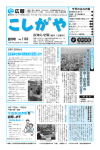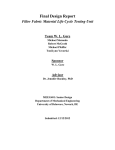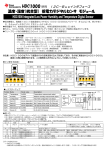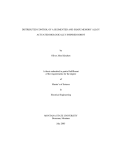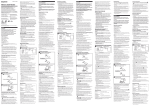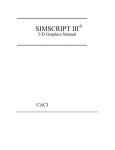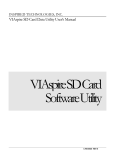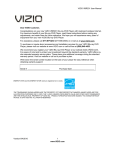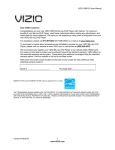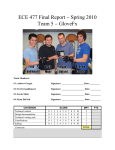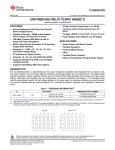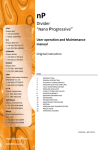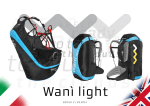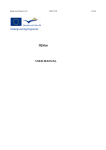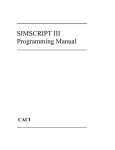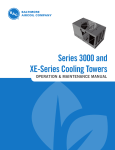Download West Pharmaceutical Services Novel Injectable Drug Delivery
Transcript
12/11/2013& & & BMEG450/MEEG401&Senior&Design&& West Pharmaceutical Services Novel Injectable Drug Delivery Project Team West Pharma BMEG Madison DeFrank BMEG Derek Hunter BMEG Ryan O’Boyle MEEG Hayley Shaw MEEG Kailey Nelson Sponsors Reginald Motley and Chris Evans Company West Pharmaceutical Services Advisor Dr. Singh Table of Contents ! ABSTRACT .................................................................................................................................................... 4& INTRODUCTION............................................................................................................................................ 5& Background&and&Significance ................................................................................................................... 5& Project&Scope ........................................................................................................................................... 5& Wants&&&Constraints ................................................................................................................................ 5& Design&Metrics ......................................................................................................................................... 6& CONCEPT&GENERATION&&&SELECTION ......................................................................................................... 6& Benchmarking .......................................................................................................................................... 6& Round&One&Preliminary&Concepts ............................................................................................................ 6& Round&Two&Preliminary&Concepts............................................................................................................ 7& Concept&Selection .................................................................................................................................... 8& Preliminary&Testing .................................................................................................................................. 8& FINAL&DESIGN............................................................................................................................................... 8& Design&Overview ...................................................................................................................................... 8& Design&Details .......................................................................................................................................... 9& Prototype ............................................................................................................................................... 10& Projected&Budget ................................................................................................................................... 10& DESIGN&VALIDATION .................................................................................................................................. 11& Failure&Analysis ...................................................................................................................................... 11& Testing ................................................................................................................................................... 12& Validation&Results .................................................................................................................................. 13& CONCLUSION ............................................................................................................................................. 13& Design&Evaluation .................................................................................................................................. 13& Deliverables ........................................................................................................................................... 13& Project&Plan&and&Path&Forward .............................................................................................................. 14& APPENDICES ............................................................................................................................................... 15& Appendix&A:&Metrics............................................................................................................................... 15& Appendix&B:&Benchmarking.................................................................................................................... 16& Appendix&C:&Preliminary&Concepts......................................................................................................... 18& Appendix&D:&Concept&Selection.............................................................................................................. 20& 2& & Appendix&E:&Initial&Testing...................................................................................................................... 21& Appendix&F:&Circuit&Calculations ............................................................................................................ 24& Appendix&G:&Failure&Analysis.................................................................................................................. 26& Appendix&H:&Projected&Budget............................................................................................................... 27& Appendix&I:&Project&Plan......................................................................................................................... 28& &&&&Appendix&J:&Drawing&Package……………………………………………………………………………………………………………..30& & & & & & & & & & & & & & & & & & & & & & & 3& & ABSTRACT West Pharmaceutical Services manufactures drug packaging and auto-injector drug delivery systems. West’s existing auto-injector products have been designed to be disposable and are intended for a single dose of medication. This method of injection, although effective, is not economical. West hopes to expand their product line to include a range of reusable drug delivery products. The scope of this project is to research and develop a novel drive mechanism that can move a piston in a 1 mL syringe and be reset for dispensing of multiple doses of medication. The final concept employs springs made of the shape-memory alloy, Nitinol, to produce the driving force for the mechanism. The final design consists of eight nitinol tension springs, six 3D-printed parts, an 11.1 V battery pack as the power source and an “on”, “off” toggle switch. The battery pack allows a heating current of 3.25 Amps to be passed through each spring, resulting in a compressive force to drive the injection of a viscous liquid. To prepare for use, a prefilled syringe can be inserted through the bottom platform and locked in place. After use, the syringe may be safely discarded and the system reset to prepare for a new injection. This design satisfies the original scope and meets all of the high priority and the majority of the lower ranked metrics making it an effective first prototype of this design. For future improvements upon this design one would alter the power source, shutoff mechanism and material choice of the parts and springs to improve efficiency. & & & & & & & & & & & & & & & & 4& & & INTRODUCTION Background and Significance West Pharmaceutical Services manufactures elastomer closures for injectable drug packaging and drug delivery system components for the pharmaceutical/biotech industry. West has two divisions, Packaging Systems and Delivery Systems. The Delivery Systems division develops and manufactures safe, multi-component systems for drug administration. We will be working with the Innovation group for Delivery Systems to research a reusable drug delivery aid for home use. Existing West auto-injector products have all been designed to be disposable and are intended for only a single dose of medication. This method of injection, although effective, is not economical. The intent is to design a device, which can be reset and used multiple times, reducing waste and increasing sustainability. Project Scope To research and develop a novel drive mechanism that can be reset and move a piston in a 1 mL syringe for dispensing of liquid. Wants & Constraints Before developing potential concepts for this design, a list of customers, wants, and constraints was compiled. The identified customers included West Pharmaceutical Services and the users. Defined as anyone in need of an injectable drug delivery system, the users included a range of clients from children to adults, and able-bodied persons to those with serious disabilities. After speaking with the sponsor, extensive research, and role playing, the design requirements were determined. An initial list of design requirements was generated and ranked based off of the sponsor’s expressed wants as well as benchmarking similar existing products, keeping the intended user in mind. For example, one expects a device that is simple to operate would prove more attractive to consumers. As a result, easy to use was established as a want and located higher on the rankings list. Overall, however, the final constraints and wants were adjusted to meet the specifications defined by the sponsor, as they are most familiar with the user’s wants. Below details the final ranked constraints and wants with corresponding descriptions. Constraints (In order of importance) • Reusable: Device can be reloaded multiple times for more than one use. • Delivers full dose of fluid: A complete dose of medication must be ejected from the syringe and administered to the user. Wants (In order of importance) • Delivers up to 50-centipoise viscous fluid: The pressure from the device must be strong enough to release a 50 centipoise viscous fluid at an adequate speed so as to avoid injuring the user. • Safe: The user will remain unharmed when using the device. A blocking device should be placed over the trigger to avoid an accidental fluid release. • Novel: The mechanism is a recent discovery or development and has not been used in the past. • Compact: A small, portable mechanism is desired. The size should be comparable to similar existing products. • Easy to use: The use of the product should be very straightforward and simple with only a minimal amount of controls to operate it. • Easy to recharge/reset: The syringe containing the medication should not be complicated to install. It should take the user less than two minutes to replace the old syringe. • Sustainable: Due to the portability and purpose of the product, it should be durable and have a long lasting lifetime. • Lightweight: Due to portability and a wide range of customers, the device should be lightweight so all users can carry and hold the device up to the skin. 5& & • • Controlled drug delivery speed: An adaptable product is ideal to accommodate multiple types of fluids, and resultantly, multiple types of medications. Cost Effective: The cost to manufacture and develop the device should remain within the Sponsor’s predetermined budget. Design Metrics After reviewing and ranking the list of wants and constraints, as well as discussing them with the sponsor, specific metrics were set. Each metric was assigned a target value with proper units. These target values were generated after thorough research of existing products on the market as well as products manufactured by West Pharmaceutical Services. The goal of the research was to understand what values must be surpassed in order to design a more effective and novel drive system. In addition, collaboration with West Innovation Team aided with the development of many of the target values. The Innovation Team provided critical information about the design based on West’s existing products. For example, the need for a compact device was assigned two metrics of max length and max width with associated target values. These target values were defined by the Innovation Team to achieve a size equal to or less than their existing drug delivery systems. Detailed in Appendix A Table 1 are the final metrics of each want and constraint, as well as the corresponding target values. CONCEPT GENERATION & SELECTION Benchmarking West Pharmaceutical Services has two products called the ConfiDose and the SmartDose, which are not yet on the market. The ConfiDose Auto-injector is spring loaded with single push button activation while the SmartDose Electronic Patch is motor driven with audible and visual drug administration indicators. All of West’s current products, while effective, must be disposed of after the first use. The LISA Auto-Injector System is a competitor product designed by Unilife that is an automated, customizable and reusable auto-injector system. This system has various injection speeds, LED indicators, push-on skin sensors, single button activation, and needle free removal compatible with easy to load pre-filled syringes. The driving mechanism for this device is undisclosed. The medical technology company BD also markets a competing reusable injector pen, the BDTM Pen II Reusable Pen, which is manually driven by the user. The only other competing reusable auto-injector product currently on the market is Cambridge Consultant’s Flexi-jectTM system, which employs flexible drug cartridges that can be squeezed by an undisclosed mechanical system to deliver a drug dose. While novel, this approach to auto-injection is incompatible with standard glass syringes making it unsuitable for adaptation in this project. After further benchmarking on possible drive mechanisms, the idea of a flat coil spring was explored. While researching to determine its specific attributes, patents related to auto-injecting drive mechanisms emerged. A patent, published in 2011, Figure'1.!A!photograph!depicting!the!design!represented!in!the! details a plunger drive mechanism using a flat coil patent!incorporating!a!flat!coil!spring. spring as the driving force. A picture of the patent is depicted in Figure 1. Although the patent does not explain the mechanism of using a flat-coiled spring, it mentions that it may be adapted for a resettable mechanism, a tool that might prove useful when generating concepts. All benchmarking related resources are listed in Appendix B. Round One Preliminary Concepts When generating a list of possible concepts it is important to keep the sponsor’s interests in mind. Through benchmarking and communication with West, multiple designs were developed to create a reusable injectable drug delivery system. An initial round of concept generation produced five preliminary concepts. 6& & SMA Concept A shape-memory alloy (SMA) is an alloy that is capable of undergoing temporary plastic deformation from its initial dimensions and still returns to its predeformed shape when heated to a transition temperature. This ability of SMAs to change shape affords the material many possible applications, one of which potentially in the field of auto-injection. This concept proposes the use of SMA springs that can easily be elongated at low temperatures but then return to a compressed state when heated by an electrical current. This spring compression Figure'2.!A!sketch!of!the!shape8memory!alloy!concept! will pull the plunger of the syringe down its longitudinal with!two!compression!springs!shown!on!either!side!of! axis, driving the liquid contained within out through the the!syringe,!driving!the!plunger!to!release!the!fluid. needle. When the current passing through the springs is shut off and the springs are allowed to return to a temperature below the alloy’s transition temperature, the springs can then easily be reset to their elongated state in preparation for future injections. An illustration of the SMA concept is depicted in Figure 2. The concepts below were also generated as round one preliminary concepts. For a detailed description of each, see Appendix C. • Soft Metal Alloy Concept • Flat Coil Spring Concept • Motor Driven Concept • Hydraulic Component Round Two Preliminary Concepts After conversing with the sponsor and presenting the initial concepts, the concern for originality in the design arose. As a result, novelty was added to the list of wants. After further benchmarking, a second round of concept generation produced additional concepts. Magnet Concept The upper casing of the auto-injector will be lined with magnets all oriented on angles with the poles facing down the shaft. Another smaller magnet will be held in place at the top of the injector within the casing as can be seen in Figure 3. After an initial activation force is applied, this magnet will be drawn farther down the injector due to the attractive force between it and the magnets lining the casing. After it is displaced, it will then be attracted to the next set of lining magnets and repelled by the previous ones. In turn this will accelerate the small magnet with enough force to exert on the plunger of the syringe. A Figure'3.!A!sketch!of!the!concept!using!magnets! neodymium magnet will be used as the one propelled since lining!the!device!to!accelerate!a!smaller!magnet! it is the strongest permanent magnet available with a wide downward.! variety of sizes. The concepts below were also generated as round two preliminary concepts. For a detailed description of each, see Appendix C. • Chemical Reaction Concept • Coil Wire Concept 7& & Concept Selection There were two main rounds of concept comparison and selection based off the project metrics. The first round included the initial five concepts; soft metal alloy, flat coil spring, SMA, motor driven, and hydraulic. After conversing with the sponsor, the motor driven concept and hydraulic component were immediately eliminated for lack of novelty in the design. The remaining concepts were ranked based on their satisfaction of each metric. From this, the concept that achieved the highest ranking was our final concept to pursue further—in this case the shape memory alloy concept. Thus, after this mathematical analysis coupled with input from the sponsor, the SMA concept was determined to be the final concept for this initial round of comparison. Refer to Table 1 in Appendix D to see the methodology behind the selection for round one comparison. A second round of concepts were generated including chemical reaction, magnet driven, and coil wire gun. These concepts underwent the same comparison process as the first round of concepts. Following this same procedure the leading design was the magnet concept. The methodology behind this selection is illustrated in Table 2 of Appendix D. After further communication with the sponsor, it was concluded that both the SMA concept and the magnet concept should be explored in more detail to determine their feasibility; therefore, preliminary testing on both concepts was conducted. Preliminary Testing Preliminary testing was performed on the magnet and SMA concept. This testing was done using various magnet sizes, number of magnets, spring vendors, number of springs and supplied voltage to the springs. Force, temperature, and current were some of the parameters tested. A summary of the experiments is given below while their details are displayed in Appendix E. Nitinol Spring Concept Testing • Experiment 1: Nitinol springs (Images Scientific Instruments). Force generated, and force to displace was measured. It was concluded that eight springs will be needed for the design. • Experiment 2: Nitinol spring (Images Scientific Instruments). Temperature, and time to cool were measured. From this experiment, 4A of current will be sufficient to provide the required force and the peak temperature of the springs is 145oC. • Experiment 3: Nitinol springs (Jameco Electronics). Force generated was measured. These new springs were less expensive than the original but produced an average force of 2.33 lb, less than that of the first springs. Neodymium Magnet Concept Testing • Experiment 4: Sets of three, four, and five magnets of increasing strength. Speed, time, and plunger rod displacement were measured. From magnet testing, it was concluded that the magnets will not produce enough force to drive the plunger rod, deeming this concept implausible. Combined SMA and Neodymium Magnet Concept Testing • Experiment 5: Two magnets. Attraction force was tested. The possible combination of the magnet and SMA concept will not be advantageous. After testing both concept ideas, as well as the combination of both concepts together, it was concluded that the SMA concept would be the final and most plausible design. FINAL DESIGN Design Overview After preliminary testing with the SMA and magnet concepts, the SMA concept was declared as the final concept. This concept incorporates the use of nitinol springs, which are shape memory alloys. This spring, when stretched to a certain displacement compresses and returns to its original length when a current is passed through it in which a battery pack is used as the power source. The idea is to attach eight 8& & springs together in a circuit such that they all compress at the same time. The combined force of the springs during compression will act as the driving force for the injectable drug delivery system. When the springs compress, they apply force to the customized plunger rod, releasing the fluid from the syringe until it is fully dispensed. After an injection is made, the stopper in the syringe will detach from the plunger rod, removing the used syringe from the system. To reset the system, the user must pull the arms of the top platform back to its original position. A new syringe is inserted into the mechanism to prepare for the next injection. Figure 4 depicts a model of the drug delivery design with all parts labeled. The drawing package for this design can be found in Appendix I. Figure'4.!A!labeled!depiction!of!the!inner!mechanism!of!the!prototype!(left).!A!labeled!depiction!of!the!prototype!encased! in!an!external!housing!(right).!! Design Details Each of the eight Nitinol springs being used in the drive shaft of the mechanism is 916$inch long when compressed with a coil diameter of 6 mm and a wire diameter of 0.75 mm. From the results of previous testing, it was concluded that each spring has the potential to produce a maximum force of 2.33 lbs when 4 amps of current is passed through each. Thus, eight springs were chosen for the design in order to be able to produce the necessary 16 lbs of force with an added factor of safety. The bottoms of the springs are fixed in place in a circle around an empty space that the glass syringe can clip into. The tops of the springs are fixed in a circle around a circular platform on which the top of the plunger rod is fixed into. Therefore, when the springs compress, the top platform will push down on the plunger rod to administer the fluid. The current passing through each spring during their compression must be precise as to not damage the springs while still & Figure'5.!A!depiction!of!the!circuit! configuration!of!the!eight!nitinol!springs!in! the!final!design. ! 9& producing a sufficient force. This value was found through circuit calculations found in Appendix F. By performing predictive calculations confirmed with validation testing using a multimeter, it was found that the actual resistance of each nitinol spring was 0.85Ω. Evaluating the current and voltage requirements for potential power sources using different circuit arrangements, it was found the most plausible circuit to maximize the force produced and minimize size is to wire four springs in series and place this in parallel with another four springs in series (Figure 5). The selected battery pack wired to the springs uses 11.1 V and has a maximum discharge current of 6.5 A (Li-Ion 11.1V 2600mAh Rechargeable Battery Pack, Tenergy). This allows a current of 3.25 A to be passed through each spring, a value approaching the 4 amps determined through preliminary testing. The contraction of the springs will be activated by a rocker switch that will complete the spring circuit. The wiring will be attached to the ends of the springs in order to eliminate obstruction during compression, while the battery will be fixed in place outside of the housing of the spring mechanism. Due to the high temperatures reached by the springs when current is passed through them, they must be insulated with a heat shielding material in order to protect the rest of the unit and the user. The material with the highest temperature resistance that is compatible with West Pharmaceutical’s 3D printer (Stratasys) is RGD5250-DM with a heat deflection temperature of 50-56°C. The 3D printed material used to manufacture the mechanism will be coated in heat shielding foil tape (Design Engineering) which reflects up to 815°C followed by a heat shielding fiberglass tape (McMaster Carr) which shields up to 260°C to further protect against the heat radiation from the springs. The use of both types of tape was necessary due to the fact that the foil tape is electrically conductive and will impede the functionality of the springs. The foil tape was still incorporated, however, due to its greater heat shielding capabilities. Prototype & The prototype consists of six 3D-printed parts (locking platform, bottom platform, plunger, top platform, external casing, ultimate top platform, Figure 5), eight nitinol tension springs, and a power source. In preassembly, the internal faces of all 3D-printed parts will be lined with two layers of heat shielding tape. Assembly begins with the eight springs being fixed to the bottom platform via screws, washers, and nuts. The driver rod is then fit into the top platform, followed by the fixture of the springs to the top platform using the aforementioned fixing method. The bottom platform can then be slid into the external casing and locked in place using the locking arms. The arms on the top platform will sit in the tracking grooves in the side of the external casing allowing for longitudinal movement and resetting. The ultimate top platform encloses the top of the external casing, confining the entire mechanism and adding support to the structure. Assembly will conclude with the power source, which will be wired to the springs in the configuration seen in Figure 6 through a highamp toggle switch. The final prototype is illustrated in Figure 6. To make ready for use, a prefilled syringe can be inserted through the bottom platform and locked in place with the locking platform that uses a press fit to maintain the syringe at the proper height to dispense a full 1mL dose. After further testing and research, the final commercial design may potentially differ in its power source and heat shielding method. Figure'6.!The!final!assembled! Alterations can be made to the SolidWorks design depending on external!view!of!the!prototype. performance, requests from sponsor, and aesthetic preferences. Once a final power source in validated a complete unit housing must be designed ! to hold the drive mechanism, power source, and toggle switch in place during use. Projected Budget Throughout the design process many components of the design have already been purchased. Some of these include the nitinol springs and magnets used for preliminary testing as described above. 10& & The projected cost of building the final prototype will include the cost of 3D printing the components, 8 nitinol springs, a roll of heat shielding tape, an 11.1V 2600 mAh Li-ion rechargeable battery pack, Li-ion battery pack smart charger, and high-amp rocker switch for a total cost of $512.84. The remainder of the hardware is provided free of charge by West Pharmaceutical Services and the Senior Design Studio. Incorporating all costs incurred, the projected budget is $931.04. West Pharmaceutical Services provides a $2000 budget meaning the project cost is well within this constraint. For specific details on ordered materials refer to the Bill of Materials in Appendix H. Mass production of 1,000 of these devices would be achieved using the method of injection molding, using the material Delrin®, an acetal homopolymer that has heat resistive properties. The projected cost of the injection-molded parts per device was found by using an injection mold estimator on custompart.net. The combined manufactured parts per device average to $104.37, which reduces the cost of each device by $270.63. All other components would be purchased in bulk, decreasing overall cost. Thus the projected cost of a commercialized device would be less than $230, which is greater than a fifty percent reduction in price, compared to the price of our final prototype. DESIGN VALIDATION Failure Analysis There were six main modes of failure that were considered for this design. First the topper component may break due to the forces the user may apply on it when resetting. To deform eight springs, one must apply about 10 pounds of force, the force each springs needs is a little more than a pound force to deform. But with this force and the thinness of the topper arms, they make break due to the moment applied. But using finite element analysis it was found that this part’s yield strength occurs at 18 pounds force, which results is a large margin of safety (please refer to figure 1 and 2 in Appendix G). The second was that the springs would fail to provide enough force to dispense the fluid. After preliminary testing was performed on the springs, six springs were deemed necessary for the design (Appendix E). A factor of safety of 2 springs was assigned to account for the uncertainty in the measurements and optimize the force needed. The third was overheating of all the exposed interior sides of the 3D printed material in the drive mechanism. Lining each of these parts with two layers of heat shielding tape (foil tape and fiberglass tape) as described in the design details mitigated this risk. Both tapes used successfully reflect against the generated heat, completely avoiding this overheating problem. The fourth mode of failure is a wiring malfunction during use. If a wire comes loose the circuit will open and not all the springs will be heated to induce contraction. This problem was addressed by fixing the wires under the screws at the end of each spring to be held in place. Overheating of the springs is another potential mode of failure. The importance of each spring receiving the proper amount of current from the battery is critical. Using 8 springs in total it was determined that an 11.1 V battery will supply 6.5 Amps to the circuit, therefore delivering 3.25 V to each spring. Through testing it was determined that this current will not overheat the springs during the time it takes to complete an injection, partially eliminating this mode of failure. Overheating can also occur when current continues to run through the springs after they are fully contracted. An on/off toggle switch and visible indicator for successful injection were implemented, completely avoiding this overheating issue. Finally, failure of springs to contract due to fatigue is the last mode of failure that was addressed. After testing many viscous fluids, the maximum number of uses until fatigue was determined. This result was a total of 15 uses with a viscosity value of 30 cP and 4 uses with a maximum viscosity value of 40 cP. If the number of uses does not exceed these values for the specified viscosities then the springs will function correctly. 11& & Testing The testing procedure was split up into two different methods: observational and experimental. Observational testing included recording the measured values of any metrics without performing any physical tests on the drive mechanism. For example, because number of sharp objects exposed is found by simply examining the device, it was categorized as observational testing. Experimental testing involved those values, which can only be deduced by running tests on the prototype. For example, the only way to accurately measure the weight of the mechanism is to run an experiment using a scale. Observational Testing of Metrics • Number of Sharp Objects Exposed: The value for this metric is very subjective depending on how some individuals may define “sharp”. As a result, a poll was taken with 10 subjects asking how many sharp objects they consider the device to have. Nine people believed there to be zero sharp objects exposed, leading to the final measured value of zero and an overall safe to use device. • Not Previously Seen/Previously Seen: The value for this metric was predetermined though benchmarking existing competing products evidenced by the second round of concept generation. A subjective rating of zero was assigned as the final measured value meaning shape memory alloys have never been used in an auto injector before resulting in a completely novel product. • Number of Controls to Perform Function: Once the final working prototype was assembled, the number of control to use the device was two. One control to turn the toggle switch on and another to reset the device using the top platform arms, making it easy to use. • Number of Speed Capabilities: The speed of contraction of the nitinol springs are incapable of being controlled especially because they have never been used in this type of application before. Consequently, at any given drug viscosity there is only one speed for the injection that cannot be controlled. • Cost: Throughout the project, all prices and quantities of every ordered material were recorded in the bill of materials. The final costs include preliminary testing, viscous fluids, prototyping, and additional costs (shipping) and amounted to $931.04 which is only 46.6% of the given budget. Experimental Testing of Metrics • Testing with 40 cP fluid: Once the final prototype was assembled, multiple trials of failure testing were performed. This consisted of using brand new springs to dispense 40 cP fluid until the springs fatigued and could no longer push the fluid out. There were four trials performed until this occurred. By filling a 1 mL syringe with this 40 cP fluid and observing as the system dispensed the full dose, a value of 1 mL was determined to be the final volume of drug delivered. • Testing with 30 cP fluid: After, 30 cP fluid was tested with a new set of springs until failure which resulted in 15 uses, achieving the reusability factor. Based on the fact that 30 cP allows for greater usability, it was assigned to be the final viscosity value meaning up to 30 cP could be delivered successfully over 10 times. From this, it can be said that more than one drug is compatible with this system because any medication ranging from 1-30 cP can be dispensed. • Time: This time corresponds to the time to reset the device. As it pertains to this final prototype, that time depends on how long it takes for the springs to cool after an injection has been made because the springs cannot stretch until this is done. The time to cool was measured simultaneously with the 30 cP fluid test where a stopwatch was used. The time was recorded from directly after the injection was made to when the springs were cool enough to be easily stretched. The average time to reset was approximately three minutes. Since the time is due to waiting time and not the addition of controls, the device remains relatively easy to reset. • Max Length/Width: The dimensions were recorded by simply taking a caliper and measuring the prototype. The final prototype is 100 mm x 60 mm, making it compact but slightly larger than the target size suggested by West. 12& & • Weight: The weight was found by placing all the components of the prototype on a scale. The 3D printed parts, springs, battery pack, and toggle switch were included in this and a weight of 0.64 lb was recorded, making it a lightweight product and adding to its portability. Validation Results After completing validation testing of the prototype, the design was evaluated by comparing its performance against the standards set by the previously established metrics. It was found that the design’s functionality was great and met many of the metrics, but more importantly many that were of high priority. Expectations for metrics such as number of uses and project cost were not only met, but also exceeded the target performance. With these successes, however, the design did also fail to meet a few metrics such as maximum length, time to reset, and number of speed capabilities. The size of the device exceeded the maximum desired dimensions, but the team agreed to not sacrifice the functionality of this device to meet the sizing component. Upon further inspection of the device, the length could be shortened to accommodate this metric and this would be done so upon the next phase of prototyping. The time to reset the mechanism exceeds the target value of two minutes, by a mere minute and this is due to the need for the springs to cool in order to reset. But this device is not one that needs to be immediately used again after each injection, thus this is not a main concern. Finally, with the power source that is used within this design, there is one steady current that runs through the springs, such that they will compress at one rate and one rate only. Thus, the metric for multiple speed capabilities is not achieved, but with the use of a more complicated power source and circuit this can be achieved. Overall, this prototype functions well as a drive mechanism that is resettable and novel, as requested by the sponsor. Thus in its entirety it successfully meets the project requirements. CONCLUSION Design Evaluation This design and prototype satisfies the original scope, that a novel drive mechanism can be resettable, thus reusable, and can generate enough force to move a piston in a 1 mL syringe to dispense medication. It meets all of the high priority and majority of the lower ranked metrics, thus this is an effective first prototype of this design that was well within the allotted budget. Upon mass production the price per device would drop drastically in comparison to the original prototype, making for a more economical design. Deliverables & Figure7:!This!figure!displays!all!of!the!deliverables!as!listed!below!of!the!final!prototype.! 13& & Deliverables provided to the sponsor include the following: • • • • • • Battery Pack Battery Charger Toggle Switch Alligator Clips Inner Assembly Parts Outer Assembly Parts Project Plan and Path Forward Throughout the entire design process, a project plan was maintained in order to ensure that the requirements and deadlines were met. Specific tasks for each phase of the project were dealt out and role delegations were assigned. Ultimately, all checkpoints were met and can be seen in Appendix I. As discussed above, the final shape-memory alloy prototype successfully satisfied all of the final design metrics except for controlled drug delivery speed, compactness, and ease to recharge/reuse. As this concept is developed further these shortcomings as well as other potential design flaws identified in testing must be considered. Outlined below are suggested directions in which to begin addressing these issues. • Custom Nitinol Springs: The main determining factor of the size of the drive mechanism is the initial size (length and coil diameter) of the nitinol springs. Due to the time and budget constraints of the project, only premade springs already on the market were researched for potential incorporation into the prototype. Motion Dynamics offers custom orders of nitinol components and might prove to be a useful source of smaller nitinol springs that will allow for a more compact drive mechanisms design. A custom order from Motion Dynamics might also be used to tailor the material properties of the springs to better suit a force generation application. A lower transition temperature of nitinol will reduce the time required to heat the springs, decreasing the time needed for the springs to begin to contract and the chances of overheating induced damage to the springs. • Alternative Power Source: The 11.1V battery pack (Tenergy) that is currently being employed to supply the current needed to heat the nitinol springs, while effective, is quite large and heavy. A potential alternative current source is ultracapacitors (Maxwell Technologies). Ultracapacitors are significantly smaller than a battery pack and are still capable of generating short bursts of current. A circuit might also be designed making it possible to adjust the rate of ultracapacitor discharge and the speed of drug delivery. One drawback of ultracapacitors, however, is that they can only store enough charge for one dose delivery by the drive mechanism and require recharging before subsequent injections. • Heat Resistant Material: In order to protect the 3D-printed components of the prototype from the high temperatures generated by the nitinol springs during drug deliver these pieces were covered in a layer of heat shielding tape. This taping is a very time-consuming process and can be avoided if these components were composed a material with a higher melting temperature. Delrin® is a commonly used material for injection molding and has a sufficiently high melting temperature (175 °C) to withstand the heat emitted from the springs, making it an ideal material for the drive mechanism. • Automatic Shutoff: As previously mentioned, one of the most likely modes of failure of the drive mechanism is failure of the springs due to heat damage. In order to prevent excessive heating of the springs and increase their lifetime it would be prudent to incorporate an automatic current shutoff into the circuit design. Once the springs have finished compressing and the full dose of drug has been delivered, the automatic shutoff will short the circuit with the power source and divert the current from the springs. A physical indicator such as a light bulb could then signal the user to turn the device off. 14& & APPENDICES Appendix A: Metrics Table'1.!A!table!depicting!the!ranked!wants!and!constraints,!corresponding!metrics,!target!values,!and!resources!used!to! determine!final!metrics.!The!target!values!associated!with!the!metrics!pressure!and!breaking!force!are!in!progress!until!the! sponsor!sends!a!document!detailing!existing!product!specifications.!The!existing!products!refer!to!products!that!West!has! developed,!but!are!not!on!the!market.! Rank Wants/Constraints Metric 1 Reusable Number of Uses 2 Volume of drug delivery Viscosity 1 mL 4 Deliver full dose of fluid Ability to deliver up to 50 centipoise of viscous fluid Safe Number of sharp objects exposed 0 Existing Product: Selfdose 5 Novel 0 Existing Products 6 Compact Easy to use 80 mm 65 mm ≤ 2 controls Existing Products 7 8 Easy to Recharge/Reset Not Seen Previously: 0 Previously Seen: 1 Max Length Max Width Number of controls to perform function Time < 2 Minutes Innovation Team and Sponsor 9 Sustainable Number of uses > 10 Existing Products 10 11 Lightweight Controlled Drug Delivery 13 Cost Weight Number of speed capabilities Number of compatible drugs Project Cost < 1 lb 1-3 Speeds (low, med, high) >1 < $2,000 Existing Products Competitors Product Example: Unilife LISA Set Budget 3 Target Value >10 ≤ 50 cP Reference Innovation Team and Sponsor Innovation Team and Sponsor Sponsor Existing Products 15& & Appendix B: Benchmarking i. West Pharmaceuticals Product Line: a. Confidose® Auto-Injector: http://www.westpharma.com/en/products/Pages/AdvancedInjectionSystems.aspx b. Selfdose® Self-Injector: http://www.westpharma.com/en/products/Pages/SelfDose.aspx c. Smartdose® Electronic Patch Injector: http://www.westpharma.com/en/products/Pages/SmartDose.aspx ii. Competitor Products: a. BD Physioject Disposable Auto-Injector: http://www.bd.com/pharmaceuticals/products/self-injection/auto-injectors.asp b. BD Pen II Reusable Pen: http://www.bd.com/pharmaceuticals/products/selfinjection/pens.asp c. SHL Group SDI MIX + NIT: http://www.shl-group.com/en/products/shlmedical/sdi-mix-nit-auto-injector.html d. UniLife RITA Auto-Injector:&http://www.unilife.com/product-platforms/autoinjectors/rita-auto-injector e. UniLife LISA Auto-Injector: http://www.unilife.com/product-platforms/autoinjectors/lisa-auto-injector f. PEGASYS ProClick Auto-Injector: http://www.pegasys.com/patient/forpatients/expect/how/proclick/index.html g. Cambridge Consultants Flexi-jectTM Auto-Injector: http://www.cambridgeconsultants.com/news/pr/release/7/en iii. Concept Generation References, Patents, etc.: a. Auto-Injector Coil Spring Patent: https://www.google.com/patents/US8038649 b. Hydraulic Shape Memory Actuator Patent: http://www.google.com/patents/US4945727 c. Light Sensitive Hydro Gel: http://www.rsc.org/chemistryworld/News/2012/March/polymer-gel-swells-3dshapes-uv-light.asp http://www.google.com/url?q=http%3A%2F%2Fweb.mit.edu%2Fnewsoffice%2F 2005%2Fsmartplastics.html&sa=D&sntz=1&usg=AFQjCNGbtRsu9rucFJIilwFNAXRxQZahPw& & & & & & & & 16& & d. Turkey Timer Figure: http://home.howstuffworks.com/pop^up^timer1.htm & Figure'1.!A!photo!illustrating!the!inner!workings!of!a! turkey!timer,!an!idea!translated!over!to!one!of!the! generated!concepts.! & & & & & & & & & & & & & & & & & & & 17& & Appendix C: Preliminary Concepts Soft Metal Alloy Concept This concept for a reusable auto-injector was inspired by the observation of basic turkey timers. These cooking timers use a soft metal alloy to hold a compressed spring in place. The soft metal is in direct contact with the material being cooked and upon being heated to a specific temperature, it melts and the spring is released and extended (refer to Appendix B figure 1 for an illustration). This same concept can be applied an auto-injector. The soft metal alloy, when heated to its melting point will release the spring and, in turn, drive the syringe downwards so that the needle is exposed and penetrates the skin to release the medicine. Flat Coil Spring Concept A basic kitchen timer with gears, and 2 flat coil springs inspires this drive mechanism concept. This auto-injector can be reset each time by twisting the dial. For different viscosities, the dial may be twisted varying amounts. As the dial winds the coil, it stores energy that activates the pinion gear, thus activating the gear train as illustrated in Figure 1. At the end of the gear train, the remaining Figure'1.!A!rough!sketch!flat!coil!spring!concept.!!In!this! energy is used to push the plunger, releasing sketch!a!pendulum!arm!press!is!employed!to!drive!the!syringe! the medicine into the patient. A possible type plunger,!but!this!component!can!easily!be!replaced!with! of gear used in this mechanism may be a rack similar!mechanisms!that!can!be!driven!with!a!gear. gear, translating rotary motion into linear motion. Another possible gear type for this design is a worm gear. Simply turning the dial, and ultimately re-coiling the flat coil spring again can reset this mechanism. Motor Driven Concept The idea for this design is inspired by West Pharmaceutical Services’ existing product SmartDose. It incorporates a motorized gear system which, when turned on, is linearly displaced and pushes on the plunger to deliver the fluid to the user. This generated concept also uses a motor as the driving force and acts in a manner similar to an adjustable wrench as seen in Figure 2. As opposed to SmartDose, however, the new mechanism is reusable. This design is simple, easy to use, and inexpensive to prototype. Figure'2.!A!sketch!of!the!motor!driven!concept!with! easily!understood!comparison!to!an!adjustable! wrench. Hydraulic Component This concept is a hydraulic component. This component would be combined with any of the other four system concepts to act as a displacement multiplier, using basic principles of hydraulics. Including channels of varying diameter can multiply force, which can be advantageous if the initial drive system is limited by minimal output force. The water channel can then be reset to its original position with the use of a prismatic slider like switch accessible on the exterior surface of the product. 18& & Chemical Reaction Concept This concept makes use of the force produced through an exothermic chemical reaction. There are many reactions capable of generating pressure through the production of gaseous byproducts and heat; however safety is a significant issue when determining which chemicals to use. The reaction between potassium chlorate and sugar (Figure 3) does not create any hazardous products, yielding only CO2 gas and water upon being heated or catalyzed with sulfuric acid. This gas can then be used to pressurize a drive shaft containing chamber, providing the force to push down the plunger and administer the drug. If sugar is used as the limiting reagent, only a fraction of the potassium chlorate provided will be reacted, allowing for multiple reactions/uses as a drive mechanism. Figure'3.!Potassium!chlorate!and!sugar!reaction! & & Coil Wire Concept This design incorporates wires coiled around the casing with a drive magnet or a ferrous metal enclosed (Figure 4). Running a current through the wires will draw the ferromagnetic driver into the coil. This concept is very dependent on the timing of passing a current through the sections of coiled wire. The current must be turned off before the driver travels halfway through the coil to maximize force. The next coiled wire will then be initiated to repeat the process. This will require a built in sequence controller and even possibly a sensor to detect the angle at which the device is being held in relation to the skin. The contact angle will affect the timing of the current being passed through the coils if there is less gravitational force aiding the driver.& & Figure'4.!A!sketch!of!the!coil!wire!concept!with!a! sequence!controller!attached!to!the!circuit!to!control! the!current!for!each!coil.! 19& & Appendix D: Concept Selection & Table'1.!This!table!displays!the!first!round!methodology!behind!how!the!team!evaluated!the!initial!concepts!in!relation!to!the! & metrics!of!greatest!importance.!Assigned!each!metric!a!priority!value!from!one!to!five,!one!being!the!most!important!and!5! being!the!least!important.!Next,!each!concept!was!ranked!from!one!to!three,!one!being!the!best,!five!being!the!worst.!From!this,! the!concept!that!achieved!the!highest!score!was!the!final!concept!to!pursue!further.! ! & Table'2.!This!table!displays!the!second!round!methodology!behind!how!the!team!evaluated!the!second!round!concepts!in! & relation!to!the!metrics!of!greatest!importance.!The!process!for!the!concept!selection!is!the!same!as!with!Table!1!above.! ! & & & & & & & & & & 20& & Appendix E: Initial Testing & Nitinol Spring Concept Testing: Experiment 1: Two Nitinol springs (Nitinol Expansion Springs, Images Scientific Instruments) tested with a total of 20 trials. Constants include: spring displacement of 1.5 inches, applied voltage of 13.8 V, and applied current of 5 amps. This test was conducted to determine the force generated by the contraction of the spring as well as the force to extend the spring 1.5 inches. This data can be found in Table 1. This experiment showed that each spring individually only produced an average of 2.82 lbs, while a total of 16 lbs is needed to administer the 50 cp fluid. This data proved that 6 springs will be needed in the final design, plus a factor of safety, resulting in a total of 8 springs needed in the final design. Table'1.!A!table!showing!the!results!from!Experiment!1!with!the!initial!two!nitinol!springs!under!constant!! displacement!and!voltage.! Experiment 2: A single Nitinol spring (Nitinol Expansion Springs, Images Scientific Instruments) was tested. During this experiment the applied current was varied. Approximately 3 minutes between each trial was allowed for cooling of the spring. This shows that with 4 amps current supplied, a sufficient amount of force is generated. One drawback however, is that the temperature of the springs reach a peak temperature of 145o C. This shows that an insulated material must be used to prevent damage. The data for this experiment is detailed in Table 2. Table'2.!A!table!showing!the!results!from!Experiment!2!with!one!nitinol!spring!under!constant!displacement!and!varying!current.! Experiment 3: Due to fatigue of initial springs, a new set of springs was purchased (Nitinol Tension Springs, Jameco Electronics) and comparative tests were conducted. Three trials were conducted using 3 Amps, and three trials were conducted using 4 Amps. Average force created was measured and recoded, while all other variables were kept constant as seen in Table 3. Compared to the old spring, this new set of spring created less force, but are still prove effective in the design. Table'3.!A!table!showing!the!results!from!Experiment!3!with!two!new!nitinol!springs!under!constant! !displacement!and!voltage!to!compare!force!data!with!Experiment!1.! 21& & Neodymium Magnet Concept Testing: Experiment 4: Sets of three, four and five magnets of increasing strength were tested with an 18 g metal drive shaft with an initial position of 80 mm from the top of the plunger rod of an empty syringe. This setup can be seen in Figure 1. Three trials for each set of magnets were run while recording the speed and time the drive shaft took to reach the plunger rod. In all 9 trials the distance that the magnetized drive shaft was able to displace the plunger rod remained at a constant value of zero. Based off this data, it has been concluded that magnets will be unable to produce the necessary force to administer the 50 cP (or any) fluid into the body. The magnet concept therefore does not meet the necessary metrics, and will be no longer pursued as a final concept. Refer to Table 4 for these data values and Table 5 for a list of strengths of the magnets used in each trial (K and J Magnetics). Since the neodymium magnet concept is no longer plausible, the addition of two magnets to the SMA spring concept is further explored and plausibility is tested. This combination of Figure'1.!Image!of!testing!setup! concepts could be beneficial in the providing addition force to the for!set!of!5!neodymium!magnets! SMA concept. with!attached!syringe!and! plunger.! & ! Table'4.!A!table!showing!results!from!Experiment!4!with!three!sets!of!magnets!of!varying!strength,!placing! !the!drive!shaft!at!a!fixed!distance!from!the!plunger!rod.! Table'5.!A!table!listing!the!strengths!of!the!magnets!! employed!in!each!of!the!trials!in!Table!4.! Combined SMA and Neodymium Magnet Concept Testing: Experiment 5: Two ½ x ½ x ½” Neodymium magnets were tested to measure the attraction force between the two 21.5 pound magnets (Note: both of these magnets were chipped, resulting in a slight reduction of pound strength). This attraction force was calculated to measure 22& & if two magnets on opposite sides of the spring mechanism would be able to aid in creating additional driving forces and can be seen in Table 6. After these tests, it has been concluded that the addition of the neodymium magnets to the spring concept will not be beneficial due to the lack of substantial attractive force generated by the magnets, and this combination will no longer be pursued. ' Table'6.!A!table!showing!the!results!from!Experiment!5!with!two!! 25!lb!magnets!at!vary!distances!apart.! 23& & Appendix F: Circuit Calculations The following details calculations for the resistance of the two slightly different nitinol springs received from separate vendors. Resistivity (ρ) of nitinol = 76 and 82 µΩ-cm in martensitic and austenitic states respectively For ImagesCo springs: Wire diameter = dw = 0.0754cm Coil diameter = dc = 0.55cm Number of turns = n = 21.4 Total length of wire = L = πdcn = π(0.55cm)(21.4) = 37.0cm Resistance=R=ρLA=ρLπ4 • Martensite: R=76µΩ∗cm37cmπ40.0754cm2!=0.63Ω • Austenite: R=82µΩ∗cm37cmπ40.0754cm2!=0.68Ω For Jameco springs: Wire diameter = dw = 0.075cm Coil diameter = dc = 0.6 cm Number of turns = n = 19 Total length of wire = L = πdcn = π(0.6cm)(19) = 35.8cm • Martensite: R=76µΩ∗cm35.8cmπ40.0750cm2!=0.62Ω • Austenite: R=82µΩ∗cm35.8cmπ40.0750cm2!=0.66Ω Resistance of springs upon measuring with a multimeter was found to be 0.850Ω on average Circuit Calculations: All 8 springs wired in parallel (Figure 1): Resistance of springs = R = 0.850Ω Equivalent resistance: 1Req=$ 1R1+$1R2+$…+$1R8=$8R Req=R8=0.850Ω8=0.106Ω • For current of 2A to flow through each spring, 24& & • • need total current of 8*2A= 16A o Required power source voltage: V = Figure'1.!A!depiction!of!the!circuit!configuration!of!the!eight!nitinol!springs! in!parallel. IR = (16A)(0.106Ω) ! = 1.7V For current of 3A to flow through each spring, need total current of 8*3A = 24A o Required power source voltage: V = IR = (24A)(0.106Ω) = 2.6V For current of 4A to flow through each spring, need total current of 8*4A = 32A o Required power source voltage: V = IR = (32A)(0.106Ω) = 3.4 V All 8 springs wired in series: Equivalent resistance: Req = R1 + R2 + … + R8 = 8R = 8*0.850Ω = 6.8Ω • • • Required power source voltage for 2A current: V = IR = (2A)(6.8Ω) = 13.6V Required power source voltage for 3A current: V = IR = (3A)(6.8Ω) = 20.4V Required power source voltage for 4A current: V = IR = (4A)(6.8Ω) = 27.2V 4 springs in series in parallel with other 4 springs in series (refer to Figure 4 in Design Details): Equivalent resistance: 1Req=14R+14R=12R; Req = 2R = 2(0.850Ω) = 1.70Ω • • • Figure'2.!A!depiction!of!the!circuit! configuration!of!the!eight!nitinol! springs!in!series! For current of 2A to flow through each spring, need total current of 2*2A = 4A o Required power source voltage: V = IR = (4A)(1.70Ω) = 6.8V For current of 3A to flow through each spring, need total current of 2*3A = 6A o Required power source voltage: V = IR = (6A)(1.70Ω) = 10.2V For current of 4A to flow through each spring, need total current of 2*4A = 8A o Required power source voltage: V = IR = (8A)(1.70Ω) = 13.6V 25& & Appendix G: Failure Analysis & Figure'1:!This!is!a!picture!displaying!the!finite!element!analysis!of!the!topper!component!with!a!tensile!force!load!of!10!pounds.! This!is!the!force!that!the!user!would!apply!on!this!component!while!resetting!the!device. Figure'2:!This!is!a!picture!displaying!the!finite!element!analysis!of!the!topper!component!with!a!tensile!force!load!of!18!pounds.! This!is!the!force!that!the!component!would!experience!failure.!As!one!can!see!the!yield!strength!of!this!component!is!far!greater! than!that!of!the!force!applied!by!the!user!during!resetting.!Thus!there!is!a!large!margin!of!safety.! 26& & Appendix H: Projected Budget ! & 27& & Appendix I: Project Plan Project Plan & & Figure'1.!A!table!depicting!the!proposed!project!timeline!for!phase!1!and!2!is!presented!above.!Project!plan!is!continually! updated!based!upon!deadlines!met!and!unforeseen!circumstances! & & Figure'3.!A!table!depicting!the!proposed!project!timeline!for!phase!3!is!presented!above.!Project!plan!is!continually!updated! based!upon!deadlines!met!and!unforeseen!circumstances! ! & 28& & Figure'4.!A!table!depicting!the!proposed!project!timeline!for!phase!4!is!presented!above.!Project!plan!is!continually!updated! based!upon!deadlines!met!and!unforeseen!circumstances.! 29& & Appendix J: Drawing Package West Pharmaceutical Services Reusable Injectable Drug Delivery User Manual 1 Table of Contents Components Included ..................................................................................................................... 3 Assembly......................................................................................................................................... 5 Attaching the Springs .................................................................................................................. 5 Attaching the Wires .................................................................................................................... 7 Inserting Plunger Rod ................................................................................................................. 8 Combine Inner and Outer Assembly........................................................................................... 9 Adding the Battery Pack and Toggle Switch ............................................................................ 10 Instructions for Use ....................................................................................................................... 11 Inserting Syringe ....................................................................................................................... 11 Delivering an Injection ............................................................................................................. 11 Resetting the Device ................................................................................................................. 13 Removing Used Syringe ........................................................................................................... 14 2 Components Included 1 Inner Assembly 8 Nitinol Springs Top Platform 16 4-40 x ½ bolts, nuts, and washers Bottom Platform Plunger Rod 1 Outer Assembly Top Casing Outer Casing 3 Additional Components Holder 1 Battery Pack 1 Toggle Switch 6 Short Wires 2 Long Cut Wires 3 Long Alligator Clips Syringe 4 Assembly Attaching the Springs 1. Top platform: Fix one end of each of the 6 nitinol springs to the top platform with 6 of each of the bolts, nuts, and washers as shown below. Once finished with this step the end of each spring should be firmly held in place between a washer and the top platform. 2. Bottom Platform: Fix the remaining free end of each spring to the bottom platform as shown below with the rest of the bolts, nuts, and washers. The arms of the bottom platform should be rotated 90° from those of the top platform if aligned correctly. As with the previous step, the end of the spring should be firmly held in place between a washer and the platform. 5 3. Verification: One end of each of the 6 nitinol springs should now be securely attached to the top platform while the other end of each spring should be securely attached to the bottom platform. If the ends of any of the springs are still able to rotate around the bolt it indicates that they are not properly held in place and the corresponding nuts should be tightened. On the other hand, if the body of either platform is experiencing any visible deformation due to the attachment of the springs, this indicates that the nuts are too tight and should be loosened before any permanent damage is done to the parts. 4. If installed correctly, the inner assembly should look like the figure below: 6 Attaching the Wires 1. Top Platform: 4 short wires should be used to connect the top of each spring to the battery pack. The wires should be attached between every other bolt from the top as seen in the figure to the right. To attach a wire its bare end should be wrapped around the bold with the nut tightened on top of it. 2. Bottom Platform: 2 short wires and 2 long cut wires should be used to connect the bottom of each spring to the battery pack. Follow the wiring directions in step one using the picture to the right as a reference. 7 Inserting Plunger Rod 1. Insert the plunger rod through the large opening in the bottom platform and push it upwards towards the top platform. 2. The plunger rod will lock into the center indentation in the top platform, completing the inner assembly. 8 Combine Inner and Outer Assembly 1. Insert the arms of the bottom platform of the inner assembly into the locking grooves in the walls of the outer casing and begin pushing it in. The top platform arms will then slide into the straight guiding grooves, fully encasing the inner assembly. 2. Slide the top casing onto the outer casing so that the top platform arms fit into grooves in top casing. 3. Rotate the top casing clockwise so the top platform arms are locked in place. 4. The final combined inner and outer assemblies should look like the figure below. Note how the long wires are still exposed. 9 Adding the Battery Pack and Toggle Switch 1. Attach the red lead of the battery pack to one of the exposed long wires with a red alligator clip. 2. Attach the black lead of the battery pack to the toggle switch with a black alligator clip. 3. Attach the remaining exposed long wire to the toggle switch using a black alligator clip. Make sure the toggle switch is in the off position before making final connection. 10 Instructions for Use Inserting Syringe 1. Insert the syringe (with plunger rod already inserted) through the hole in the bottom of the outer casing. 2. Lock the bottom holder in place on the bottom of the outer casing to fix the syringe in position. Delivering an Injection 3. Before activating the drive mechanism, twist the top casing counterclockwise to unlock the top platform arms to allow them free movement in the guiding grooves. 11 4. Flip the toggle switch into the on position to begin injection. 5. A successful full delivery of drug is indicated by the top platform arms reaching the bottom of the guiding grooves. When this occurs, flip the toggle switch into the off position. 12 Resetting the Device 6. Once the device cools (~3 minutes) the top platform arms can be pulled upward in the guiding grooves. 7. When the top platform arms reach the top of the grooves, turn the top platform clockwise to lock the arms into position. 13 Removing Used Syringe 8. Pull the bottom holder out of its locked position to free the syringe. 9. The syringe can now be disposed of safely. 14





















































